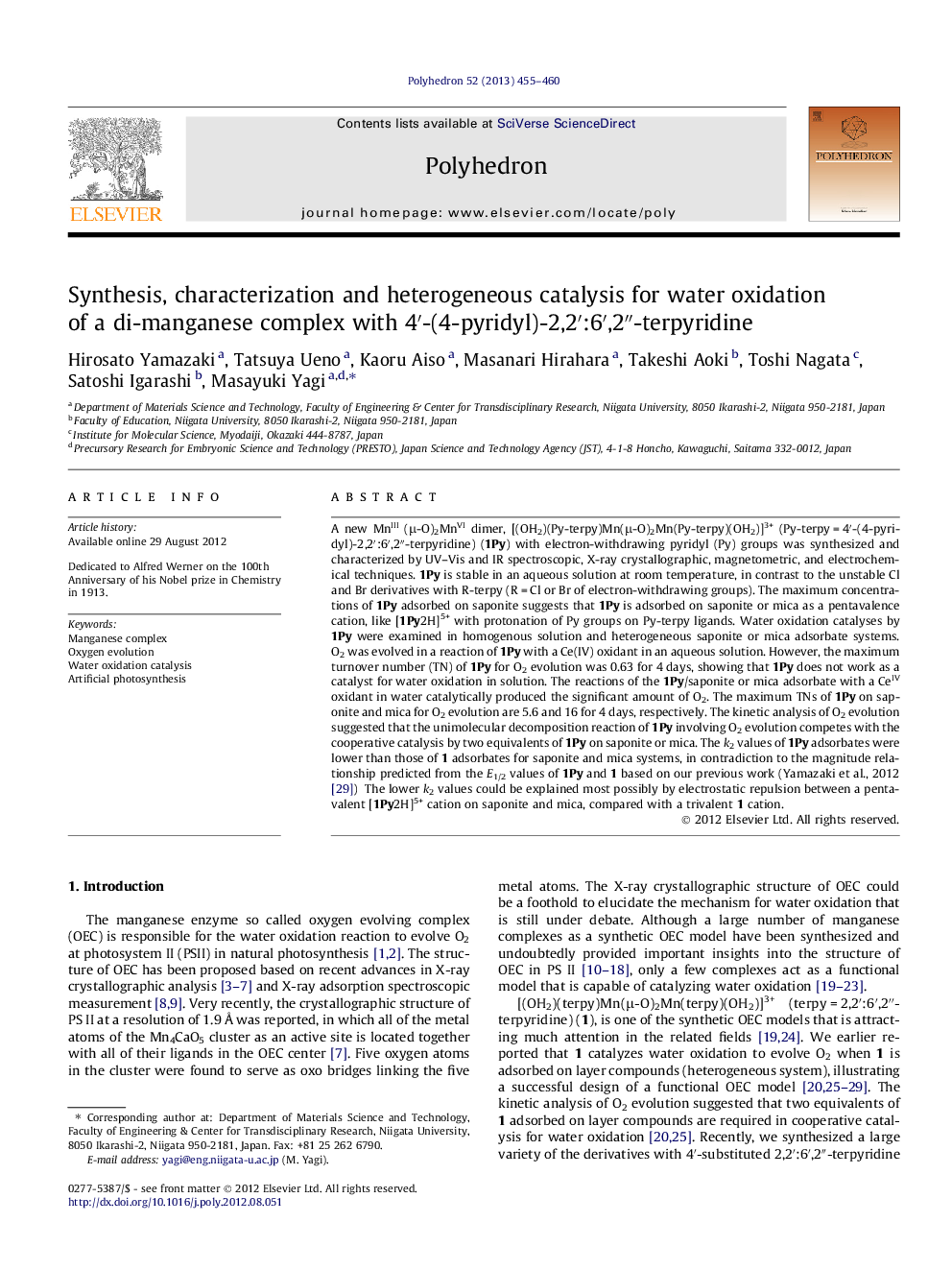| کد مقاله | کد نشریه | سال انتشار | مقاله انگلیسی | نسخه تمام متن |
|---|---|---|---|---|
| 1336971 | 1500287 | 2013 | 6 صفحه PDF | دانلود رایگان |

A new MnIII (μ-O)2MnVI dimer, [(OH2)(Py-terpy)Mn(μ-O)2Mn(Py-terpy)(OH2)]3+ (Py-terpy = 4′-(4-pyridyl)-2,2′:6′,2″-terpyridine) (1Py) with electron-withdrawing pyridyl (Py) groups was synthesized and characterized by UV–Vis and IR spectroscopic, X-ray crystallographic, magnetometric, and electrochemical techniques. 1Py is stable in an aqueous solution at room temperature, in contrast to the unstable Cl and Br derivatives with R-terpy (R = Cl or Br of electron-withdrawing groups). The maximum concentrations of 1Py adsorbed on saponite suggests that 1Py is adsorbed on saponite or mica as a pentavalence cation, like [1Py2H]5+ with protonation of Py groups on Py-terpy ligands. Water oxidation catalyses by 1Py were examined in homogenous solution and heterogeneous saponite or mica adsorbate systems. O2 was evolved in a reaction of 1Py with a Ce(IV) oxidant in an aqueous solution. However, the maximum turnover number (TN) of 1Py for O2 evolution was 0.63 for 4 days, showing that 1Py does not work as a catalyst for water oxidation in solution. The reactions of the 1Py/saponite or mica adsorbate with a CeIV oxidant in water catalytically produced the significant amount of O2. The maximum TNs of 1Py on saponite and mica for O2 evolution are 5.6 and 16 for 4 days, respectively. The kinetic analysis of O2 evolution suggested that the unimolecular decomposition reaction of 1Py involving O2 evolution competes with the cooperative catalysis by two equivalents of 1Py on saponite or mica. The k2 values of 1Py adsorbates were lower than those of 1 adsorbates for saponite and mica systems, in contradiction to the magnitude relationship predicted from the E1/2 values of 1Py and 1 based on our previous work (Yamazaki et al., 2012 [29]). The lower k2 values could be explained most possibly by electrostatic repulsion between a pentavalent [1Py2H]5+ cation on saponite and mica, compared with a trivalent 1 cation.
A new dinuclear MnIIIMnIV compound with electron-withdrawing groups has been synthesized and characterized.Figure optionsDownload as PowerPoint slideHighlight
► [(OH2)(Py-terpy)Mn(μ-O)2Mn(Py-terpy)(OH2)]3+ (1Py) was synthesized and characterized.
► 1Py is adsorbed on saponite or mica as a pentavalence cation.
► The reactions of the 1Py/saponite or mica adsorbate with a CeIV oxidant in water catalytically produced the significant amount of O2.
► The unimolecular decomposition reaction of 1Py competes with the cooperative catalysis by two equivalents of 1Py on saponite or mica.
Journal: Polyhedron - Volume 52, 22 March 2013, Pages 455–460